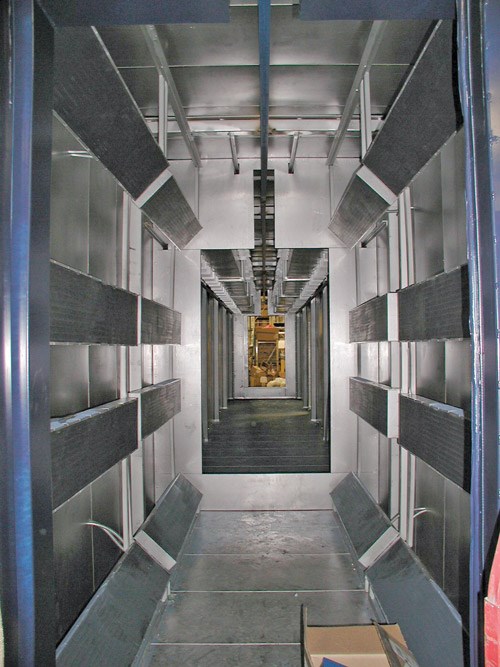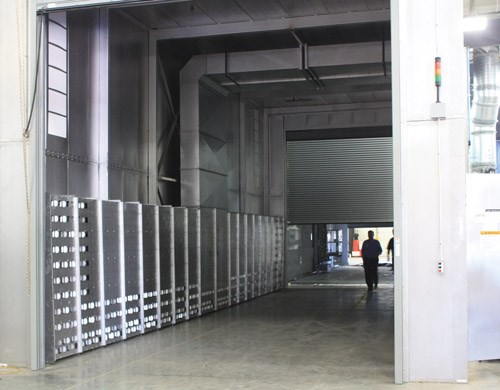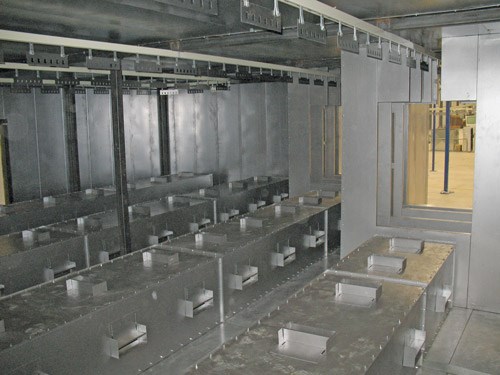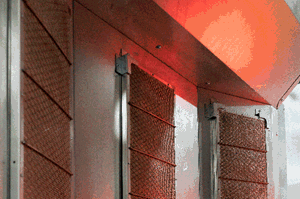Increase Your Profits by Improving Your Oven
A guide for choosing an efficient, uniform oven system to quickly complete the process.
During the finishing process, curing the coating often has the longest dwell time in the process and is one of the few processes that you can speed up without damaging the quality. Choosing a high-quality oven will enable you to complete the process as quickly as possible.
There are many factors to consider when purchasing an oven. Price shopping is important, but make sure you are comparing apples to apples. Purchase the best quality oven you can afford because a high-quality, uniform oven is more cost effective and can improve quality and increase throughput.
Coaters are not often critical of oven uniformity, but they should be. Completing a batch five minutes quicker could add two or more batches per day, which means more product through the shop and more money saved.
For example, say the business plan is to cure a part in 30 minutes. With a substandard oven, it takes 45 minutes (50 percent longer) to cure, cutting production half. If each rack or cart is worth $1,000 and the line does two racks per hour in an eight-hour shift, the line completes 16 racks, or $16,000, in a perfect operation. The line completes 8.73 racks per shift, or $8,730–$7,270 less than what might have been possible with a better oven.

There are multiple ways to heat an oven, the most common of which are natural gas and electric heat.
Time is Money
If the system is a continuous moving line, the same holds true. If a system is bought to do 6 feet per minute, but cannot cure the part properly in the time allotted, the line must be slowed down. Less product can go through the shop in a day, which potentially means less revenue.
If the line is run at 6 feet per minute for eight hours a day, the total feet of travel in a day is 2,880 feet. To compare, if the line can only run at 5 feet per minute for the same amount of time, the total feet of travel per day is 2,400 feet. That is a difference of 480 feet a day. How many parts can be produced in that length? And how much revenue can be earned per part?
Say the system produces revenue per hour. Let’s pick a dollar volume—$10,000 per hour at a 6 feet per minute line speed. The line travel is 2,880 feet per eight-hour shift, or 360 feet per hour. At 5 feet per minute, there is 480 feet less of product through the line a day, and 480 feet equates to 1.33 hours or $13,300 at 6 feet per minute. So you lose more than $10,000 per shift by decreasing the line speed to 5 feet per minute.
Another way of looking at it is breaking down the revenue per foot. At 6 feet per minute, the line can earn $80,000 in 2,880 feet, or $27.78 per foot. At 5 feet per minute, multiplying 2,400 feet per shift by $27.78 per foot, the total revenue per shift is $66,672. This is a loss of $13,328 in potential revenue. Changes in this line speed can directly impact the revenue.
Here are some things to consider before purchasing:
Airflow. In many batch ovens, heated air is introduced from a supply duct on both sides of the oven. Air is directed at the part on a cart in the middle of the oven. Heated air impinges upon the part from both sides. This airflow style, known as center flow, is an effective way of heating a part. However, some ovens have a crossdraft airflow where air enters from one side of the oven, is pulled over the part and exhausted on the other side. Another airflow style is downdraft where heated air comes from the top down to side ducts or a floor-mounted duct. Products cure the most effectively when the heated air directly impinges upon the part. If the heated air does not go directly to the part, some heat is lost. Analyze the required airflow and make sure to purchase an oven that meets this criterion.
Air changes. In addition to airflow style, look at air velocity, the number of air changes and cubic feet of air per minute; the more air changes, the quicker the air is reheated. Air moves through the oven quicker and should impinge upon the product more, providing a quicker temperature rise or cure. For powder applications, be aware of air velocity until the powder is melted and will not get blown off the product. For wet coatings, consult a coating supplier in regards to flash-off time, solvent pop.
Heating capacity. The burner is an important function of the oven because it heats the air. The burner should be sized to handle the load capacity for a bulk load or the pounds per hour of the line speed. Compare BTU and kWh in the oven specifications.
Heat and fuel source. There are multiple ways to heat an oven, the most common of which are natural gas and electric heat. Other options include infrared, propane and steam. Look at the cost and accessibility of the fuel sources. In some countries, propane is more common. Steam can be an excellent source if the company is already generating steam of sufficient pressure and capacity. Infrared is less common for batch ovens, but has been used in continuous conveyor ovens for many years because it can offer faster line speed, less gap between color changes and increased productivity.
Temperature range. Many customers ask for temperature range tolerance (uniformity) without understanding the requirements and process to test this. Before determining a tolerance, ask these questions: What standard are you quoting from for this uniformity? How many thermal couples are going to be inside the oven? Are you looking at air temperature or part temperature?
Uniformity is typically established after the oven is installed, and racking or parts positioning is tested to determine the optimum uniformity and temperature ranges required for production needs. Repeat the racking or parts positioning each time to maintain uniformity. If uniformity is critical to the operation, purchase an oven that can achieve this uniformity. Look at the production needs and temperature ranges, as well as how to rack those parts.
Insulation. A well-insulated oven is a more efficient oven. Insulation prevents heat loss and ensures exterior surfaces are safe to touch. Although insulation is important, more is not necessarily better. Look at the insulation density and R-values for comparison.
Controls. Basic control packages include an on/off switch and temperatures settings, and this may be enough, depending on the application needs. More advanced controls enable oven adjustments based on the product load, the type of part and the different coatings.
Exhaust volumes. An oven should remove a sufficient volume of air so the correct volume of combustion air can be supplied. For a dry-off oven, the exhaust volume needs to expel a sufficient volume of air to remove humidity. On lower temperature ovens, exhaust will help keep an oven cool. Some fans, when running for a long period of time, can add 30°F or more to the temperature rise. An oven should not exhaust more than needed because it’s throwing away energy—and energy is money.
To save energy, heat can be recovered from the exhausted air with a heat recovery system. The recovered heat can be used for other processes or to heat the building. A local utility may also help in paying for a heat recovery system.

In many batch ovens, heated air is introduced from a supply duct on both sides of the oven.
Best practices, maintenance. Over- or under-cured parts can result in scrap, lost productivity and reduced revenues. A customer recently acknowledged that it is four times more expensive to reproduce a product than if it had been produced correctly the first time. Follow best practices to reduce rework, improve quality and increase efficiency.
Air balancing. Make sure the oven is balanced at startup. In a batch oven, rack critical parts the same each time and balance the air to enhance the cure of these parts. For a conveyorized oven, make sure there is an even air supply throughout the oven to eliminate cold spots. Be aware of conveyor openings where cool incoming air may affect the temperature. Compare duct sizes, air volumes, fan quantities and oven layouts.
Part positioning. If an operation requires repeatability, plan for it and repeat the same steps correctly. Part positioning is critical in industries where absolute uniformity and product runoff is required to commission an oven and system. If this is critical, then the oven supplier will require that the customer place the product in the same spot in the oven every time. Changing part positioning can drastically change airflow and uniformity.
Cold spots. A cold spot in the oven will cause a longer cure time for the part, which slows down production and costs money. Balance the oven and speed up the cure times. Rack parts to assist, or at least not hinder, the heat transfer. Some ovens cannot overcome the initial design limitations and will not produce what is needed in the time allotted.

Over- or under-cured parts can result in scrapped parts, lost productivity and reduced revenues.
Making the Decision
There are many considerations, including budget. Many times, the right product is available through thorough research. However, these important points or requirements will help in the beginning stages of the buying process and will affect the cost and thin out the possible supplier list. Place time and a dollar figure into the previous calculations and assign a value to the production line and line speed.
Invest in a high-quality, uniform oven that will cure parts from top to bottom quickly each time. Though a good oven will cost more up front, it ultimately pays for itself.
Marty Powell is the industrial territory manager for Global Finishing Solutions Contact him at 800-848-8738, or visit globalfinishing.com.
Originally published in the April 2016 issue.
Related Content
Oven Door Technology Improves Energy Efficiency
The RollSeal Door brings a compact, energy efficient and safe design to batch and conveyor style thermal processing units.
Read MoreCuring Oven Basics
Simply heating up the substrate does not cure the coating. There are many variables to consider when choosing the best cure oven for your application...
Read MoreOven System Wins Pace Award
The EcoInCure is designed to cure complex car bodies with superior paint quality faster and more efficiently than conventional ovens.
Read MoreSpecialty Oven’s Hot Benefits and Other Questions Answered
Learn about the advantages of gas catalytic infrared pre-gel ovens in this article, including how they are energy efficient and can save users time and money when integrated into their existing systems.
Read MoreRead Next
Reducing the Chance of Spray Booth Fires
In the finishing industry, there is a real connection between safety and quality—especially when it comes to spray booths, which can run the risk of causing fire if not properly maintained. A review of basic safety precautions, plus a look at the National Fire Prevention Association standards that address fire safety in Spray booths.
Read MoreDelivering Increased Benefits to Greenhouse Films
Baystar's Borstar technology is helping customers deliver better, more reliable production methods to greenhouse agriculture.
Read MoreEpisode 45: An Interview with Chandler Mancuso, MacDermid Envio Solutions
Chandler Mancuso, technical director with MacDermid Envio discusses updating your wastewater treatment system and implementing materials recycling solutions to increase efficiencies, control costs and reduce environmental impact.
Read More












.jpg;maxWidth=300;quality=90)








